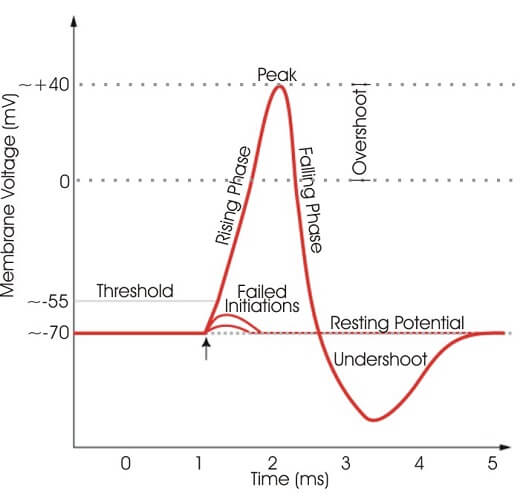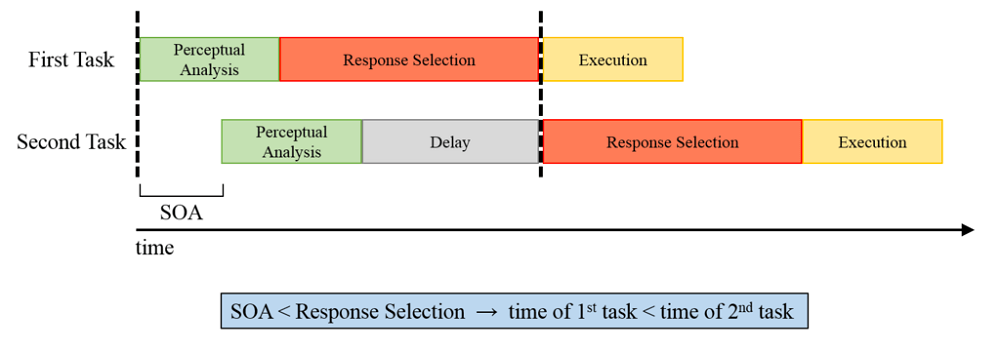Definition
The refractory period of a neuron is the time in which a nerve cell is unable to fire an action potential (nerve impulse). Two subsets exist in terms of neurons: absolute refractory period and relative refractory period. The first describes the inability to send a new impulse when sodium channels preceding this impulse are inactivated. Relative refractory periods describe an interval immediately following the absolute type, where a second impulse is only inhibited. Even so, transmitting this second impulse is possible but only if the stimulus is great enough.
What is Refractory Period?
To understand the refractory period, you need to know about how electrical messages are transferred from nerve cell to nerve cell or from nerve cell to other tissue cells.
Action Potentials
Neurons are integral to the central and peripheral nervous systems. A typical neuron is composed of a soma (cell body), dendrites, and an axon. There are many different types of nerve cell; a generic neuron receives chemical signals via neurotransmitters arriving at the dendrites and forwards these signals down the axon to the next cell by way of electrical impulses.

Dendrites can be imagined as tree branches that absorb energy and nutrients from the environment. The branches send energy (and nutrients) along the trunk of the tree – the axon.
Neurons are electrically-excitable cells. When stimulated, the voltage along the cell membrane changes one section at a time in the direction of the target cell. When a neuron is stimulated, the subsequent voltage change moves along the axon. This voltage change is called an action potential.
Once an action potential reaches the end of the axon at a place called the terminal, that neuron releases neurotransmitters (chemicals) to the next neuron or target cell – often a muscle cell. If the target cell is another neuron, this absorbs signaling neurotransmitters via the dendrites.
Between the terminal of the previous neuron and the dendrite of the next is a gap called the synaptic cleft. Neurotransmitters must float across this gap to forward a message. These chemical messages either excite or inhibit the receiving neuron. If excited, the receiving neuron generates an action potential of its own.
Ion Channels
An axon has multiple channels running through its membrane. These include sodium (Na+) and potassium (K+) ion channels. Electrical charges or chemical signaling open and close these channels.

As ion channels open or close, the electrical charge on the inside and outside surfaces of the neuron membrane changes. This does not occur all at once but section by section.
In myelinated neurons where the cell membrane is covered by a thick protein sheath, this is not possible. The sheath would stop ion channels from functioning if they were placed under such a thick covering. Instead, changes in membrane voltage continue to be transmitted by ion channels located at the nodes of Ranvier – unmyelinated areas. With a different concentration of ions inside and outside the neuronal cytoplasm, ions are encouraged to move in or out of the cell to achieve equilibrium.
When Na+ channels open at the start of an action potential, Na+ ions from outside the cell flood in; that part of the neuron becomes positively charged. When K+ channels open, K+ ions from inside the cell flood out, and that part of the neuron membrane becomes more negatively charged. It is these mechanisms that change the voltage of the cell membrane.
An action potential rarely travels backward thanks to the refractory period. Once ion channels have closed, they need time to reopen. This means that the negative charge produced at one point of the cell membrane is attracted by the positive charge of the next portion. The negative charge stimulates a reaction from the next group of ion channels and the action potential travels along the axon.
Action Potential Phases
At resting state (resting potential), the inside of the neuron that lies close to the membrane is more negative than its extracellular environment. Typically, the voltage of a resting neuron is -60 to -70 millivolts (mV). This voltage fluctuates according to the strength of an incoming stimulus. However, for a neuron to transmit an action potential, the intracellular space closest to the membrane must first reach a threshold level of –55 mV. If this is not achieved, an action potential cannot be initiated.

Once the intracellular side of the neuron membrane reaches –55mV, Na+ ion channels positioned closest to the dendrites open. Sodium ions enter the cell; the surrounding intracellular space becomes more positively charged. This is called the depolarization phase. Depolarization occurs along the axon in a wave-like form. This phase describes the membrane potential becoming more positive than the resting state.
Remember that sodium ions are most commonly positioned outside the membrane and when they enter the neuron their positive charges increase that part of the membrane inside the cell; positively-charged potassium ions are most commonly found inside the cell and when they flood out, the inner side of the membrane becomes more negatively charged.
Once the intracellular voltage of the neuron reaches approximately +30mV, Na+ ion channels in that part of the membrane start to close and K+ ion channels open.
Potassium ions flood out of the neuron and into the extracellular space. This is the repolarization phase. Again, repolarization occurs in waves along the axon membrane. This phase describes the membrane potential becoming more negative than during depolarization.
As with all neurological pathways, the on-off switch is not infallible; instead of stopping immediately as resting potential is achieved, ions continue to move through their channels for a very short time. During this period, that part of the membrane becomes hyperpolarized – more negative than resting potential.
At the hyperpolarization phase or overshoot phase, the inside surface of the neuron membrane reaches a voltage of approximately -70 to -75mV. Only once all of the potassium ion channels have closed can resting-state values be achieved.

Absolute vs Relative Refractory Period
With the above information, it is now possible to understand the difference between the absolute refractory period and relative refractory period. In terms of an action potential, refractory periods prevent the overlapping of stimuli.
In theory, each action potential requires around one millisecond to be transmitted. This means we could expect a single axon to forward at least one thousand action potentials every second; in reality, this number is much lower. The absolute refractory period lasts for approximately one millisecond; the relative refractory period takes approximately two milliseconds.

Multiple action potentials do not occur in the same neuron at exactly the same time. This is because a neuron experiences two different situations in which it is either impossible or difficult to initiate a second action potential. These two situations describe the two types of refractory periods.
During the depolarization phase when Na+ ion channels are open, no subsequent stimulus can create a further effect. An ion channel does not open by degrees – it is either open or closed. This is the absolute refractory period (ARP) of an action potential. A second action potential ‘absolutely’ cannot occur at this time. Only after the Na+ ion channels in this part of the membrane have closed can they react to a second stimulus.
The relative refractory period (RRP) occurs during the hyperpolarization phase. The neuron membrane is more negatively-charged than when at resting state; K+ ion channels are only just starting to close. However, all sodium ion channels are closed so it is – in principle – possible to initiate a second action potential. This requires a stronger stimulus as the intracellular space is more negatively charged. To excite a neuron by reaching the threshold level of –55 mV, a greater stimulus is required. It is, therefore, ‘relatively’ difficult but not impossible to start up a second action potential during the relative refractory period.
The relative refractory period is extremely important in terms of stimulus strength. The rate at which a neuron transmits action potentials decides how important that stimulus is. There is no such thing as a weak or strong action potential as all require the same level of electrical or chemical stimulus to occur. Either threshold level is achieved and the neuron fires, or it does not.
It is the firing rate not the firing strength that causes different effects. For example, in low light levels, cells in the retina of the eye transmit fewer action potentials than in the presence of bright light. We see much better when light levels are high because more information is passed from the retina to the brain in a short time.

Effective Refractory Period
In heart pacemaker cells that act very similarly to neurons, another type of refractory period exists – the effective refractory period or ERP.

This timespan occurs at the same time as the ARP but ends immediately before the RRP. It is often ignored in textbooks, as is the case in the above image. We should imagine the absolute refractory period ending a millimeter or two before the relative refractory period in the above diagram. The effective refractor period covers all of the time within the ARP as well as those final millimeters.
At this point, sodium ion channels have closed and it is possible to generate a second action potential. However, unlike the RRP, the effective refractory period does not allow conduction. In this case, the ERP of myocardial cells stops the heart from contracting prematurely and upsetting the heart rhythm.
Refractory Period in Psychology
The word refractory means stubborn or resistant to a process. In terms of action potentials and neurons, this is self-explanatory. A neuron is resistant to a second action potential during refractory periods.

In psychology, refractory period means a delay in response. This is not something to do with our intelligence but our reaction times – this refractory period is, therefore, also to do with our nerve pathways but on a broader scale. The psychological refractory period (PRP) describes being unable to react to a second stimulus as the body and/or brain is still busy responding to a first stimulus.
For example, when drinking alcohol, our reactions and reflexes are impaired. The presence of alcohol together with another task affects our reaction speed. If you drive a car under the influence and the car in front of you brakes suddenly, your reflex to brake will be slower than if not drinking. If, as the car in front brakes, a passenger in the car asks a question, the driver may not hear it. Alternatively, the driver may hear the question very clearly but not see the car in front suddenly stop. Their psychological refractory period prevents us from processing two tasks at once.

Other biology-related uses for this term exist. One example describes the pause between male orgasm and a second erection. Many sexual aids and medications (such as Viagra) focus on trying to shorten refractory periods in men.


